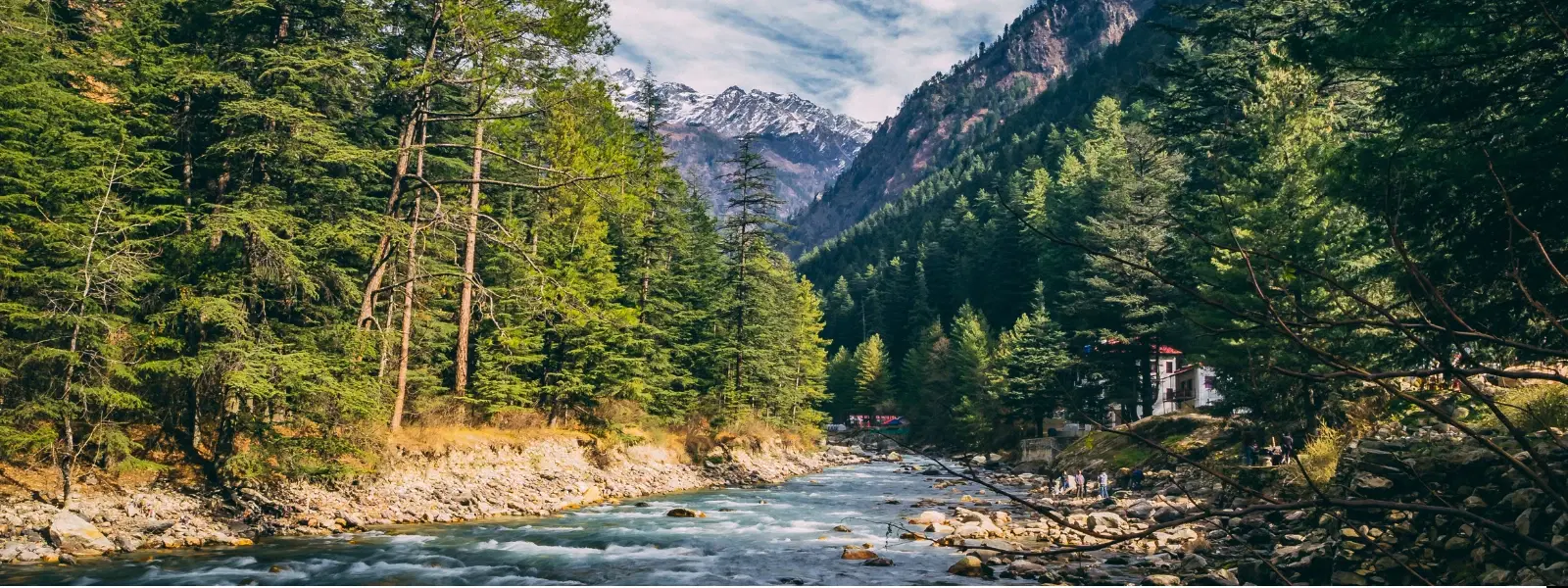
Hotels
•05 min read

Tirthan Valley, with its breathtaking landscapes, inviting weather, and myriad of outdoor activities, promises a refreshing escape for nature lovers and adventure seekers alike. This hidden gem in the Himalayas beckons trekkers, photographers, and families to immerse themselves in its serene environment. The experience you have largely depends on the timing of your visit, making it essential to align your travel plans with the valley’s dynamic weather and seasonal activities. This comprehensive guide details the seven best months to visit Tirthan Valley, ensuring your trip is perfectly timed for the best weather and an unforgettable adventure.
Tirthan Valley enjoys a temperate climate shaped by its Himalayan altitude. The weather shifts distinctively across seasons: spring paints the valley in a palette of blooming flora, summer brings warm days ideal for camping and fishing, monsoon refreshes the landscape with intermittent rains, autumn graces the area with clear skies and moderate temperatures, and winter transforms the valley into a snowy wonderland. The altitude makes for cooler climates, especially during winter, and more pleasant conditions in the shoulder seasons.
Weather affects every aspect of travel—from the accessibility of scenic spots to the suitability for outdoor activities like trekking and sightseeing. Each season in Tirthan Valley brings its own set of attractions and challenges, making it imperative to plan based on what you wish to experience. In the sections that follow, we explore the seven best months to visit, each offering a unique perspective on this beautiful destination.
As the valley emerges from the chill of winter, March and April offer inviting temperatures, with nature in full bloom. The clear, crisp air and blossoming landscapes create perfect conditions for trekking along the popular trails, such as the Jalori Pass. In addition to trekking, the period is ideal for venturing into The Great Himalayan National Park and exploring quaint local villages that spring to life after winter. Enjoy the invigorating freshness that comes with spring—a time when nature reawakens in its full glory.
May and June bring mild temperatures that make Tirthan Valley a favourite escape for families and adventure enthusiasts. Here, the weather is just right for outdoor pursuits such as camping by the river, fishing for trout, and exploring cascading waterfalls. Long, sunlit days allow ample time to delve into the valley’s rural charm and relish local delicacies without the interference of extreme heat or heavy rains.
The duo of September and October marks one of the most captivating periods in Tirthan Valley. The monsoon rains having left behind lush greenery, the valley presents clear skies and moderate temperatures—a perfect setting for photography, exploration of age-old villages, and sampling seasonal local cuisine. Autumn in Tirthan Valley offers a balanced blend of calmness and adventure, making it an excellent choice for travelers looking to escape the hustle and bustle of city life.
December transforms Tirthan Valley into a serene winter wonderland. The chilly weather and occasional snowfall create a magical setting especially suited for winter treks and cozy nights in sumptuous accommodations. This festive season is ideal for those who relish solitude amidst tranquility and the crisp, clean air of snow-covered landscapes.

Tirthan Valley offers a wide range of stays to suit every traveler’s taste and budget. Visitors can opt for traditional homestays that provide an immersive cultural experience or select eco-lodges that focus on sustainability and a closer connection with nature. For those who prefer a more modern setup, there are hotels and guesthouses equipped with all the amenities, ensuring a comfortable and convenient stay.
For travelers looking for both convenience and comfort, several hotels near Tirthan Valley have garnered great reviews. These establishments provide easy access to major tourist attractions and trekking sites, all while ensuring a warm and hospitable environment. Whether it’s a luxury resort or a budget-friendly option, accommodations in and around the area meet the varied needs of every visitor. The keyword hotels near Tirthan Valley resonates with those seeking established lodging options during their trip.
To secure the best deals and ensure availability, it is advisable to make your booking well in advance, particularly during the peak travel months. Off-season travel not only provides competitive pricing but also fewer crowds, enhancing your overall experience.
The valley is dotted with attractions that cater to diverse interests. The majestic Jalori Pass offers panoramic views, while ancient monuments like Raghupur Fort reveal tales of the region's historic past. Towns like Gushaini add a rustic charm to the journey, where architecture and natural beauty merge seamlessly. Seasonal experiences such as a winter snowfall or a lively spring trek further enhance these tourist attractions.
Trekking in Tirthan Valley is a must for adventure enthusiasts. Trails like the Serolsar Lake Trek cater to a variety of skill levels, from novice trekkers to seasoned hikers. The best months for such activities are clearly outlined in prior sections, ensuring that your trail experience is both challenging and rewarding. The well-marked paths and local guides add to the appeal, allowing you to explore hidden gems safely and informatively.
No visit to Tirthan Valley is complete without savoring its local dishes. The region’s cuisine, heavily influenced by local traditions, features rustic meals such as Siddu, hearty soups, and the famous trout fish dishes. Seasonal ingredients and recipes passed down through generations contribute to a food experience that complements the valley's natural beauty and appeal.
Getting to Tirthan Valley is a smooth journey with options including road, rail, and air travel. For travelers coming from major cities like Delhi or Chandigarh, the well-connected road networks provide a scenic drive through the Himalayan foothills. Train journeys to nearby towns followed by short road transfers are common, while the nearest airports connect Tirthan Valley to the wider region. Each season brings unique travel considerations, so plan routes and timings accordingly to ensure a seamless journey.

Packing wisely can significantly enhance your trip. For winter visits, include warm clothing, thermal wear, and waterproof boots. Spring and autumn travelers should invest in light layers and sturdy trekking shoes, while summer excursions call for breathable fabrics, sun protection, and adequate water supplies. Tailor your packing list closely to the specific weather forecast and the activities you plan on participating in.
Pro Tip: Plan Like a Local!
Did you know that visiting Tirthan Valley during the shoulder seasons (March-April and September-October) not only gives you the best weather but also helps you avoid the crowds? You can secure better deals on accommodations and enjoy a more peaceful, authentic experience.
The ideal time to experience snowfall in Tirthan Valley is between December and February.
A 3-5 day trip is generally enough to explore the main attractions and soak in the valley’s natural beauty.
Absolutely, it is a hidden gem known for its pristine landscapes, thrilling outdoor activities, and peaceful retreats away from the typical tourist crowds.
The valley experiences a temperate climate with cool summers, chilly winters, and moderate monsoon rains.
Typically, March to June or September to November are the most pleasant months to visit Jibhi, offering mild weather and lush environments.
In conclusion, Tirthan Valley is a destination that offers a year-round feast for the senses. However, choosing the right month to visit can elevate your experience, whether you prefer the rejuvenating blooms of spring, the welcoming warmth of summer, the serene beauty of autumn, or the sparkling allure of winter. This guide has outlined the optimal travel periods tailored to varied interests, ensuring that your journey is as enchanting as it is memorable. Dive into the charm of Tirthan Valley, relish its local cuisine, explore its historic trails, and experience the tranquility that only these pristine Himalayan landscapes can provide.